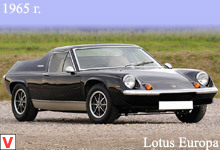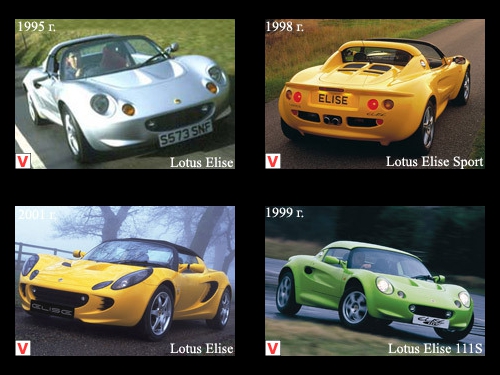
The small 2-seater mid-engined roadster Elise debuted in 1995 in Frankfurt. With its appearance, a new era began in the history of the company Lotus. The model immediately gained great popularity among sports car enthusiasts. The secret of success is an unusual, futuristic appearance and original bodywork. Nontrivial appearance perfectly combined the classic and modern. The incomparable exterior immediately caught the eye.
The size of the front discs is smaller than the rear ones (5.5 "x16 and 7.5" x17, respectively), this added to the appearance of the speakers. Initially, the model was equipped with a vinyl soft roof. In 1997, began to offer a removable hard top - hardtop.

Elise received a central location engine in front of the rear axle and light alloy chassis elements. The bearing base of the roadster was made of aluminum panels weighing only 70 kg. External body panels made of composite materials are hung on it and the steel beam of the rear axle and the protective arc are bolted on. Applying light alloys, engineers have achieved a surprisingly small weight of the car - only 690 kg. The space frame is not made of steel pipes, but of light alloy.
The extruded aluminum-magnesium alloy strips with integrated seat-belt anchorages and a lightweight steel rear subframe are connected to each other using a special adhesive that hardens at a temperature of two hundred degrees for two minutes. Crosswise in front of the rear axle in the Lotus Elise is a 4-cylinder 16-valve Rover K-Series engine with two overhead camshafts and a variable valve timing (VVC) system. In order to reduce the total weight of the engine is entirely made of aluminum. Engine capacity is 1.8 liters capacity of 122 hp. From a place up to 100 km / h, the car accelerates in 5.9 seconds. The maximum speed is 202 km / h.
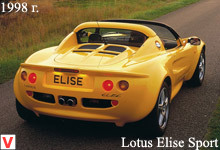
Fuel consumption per 100 km in urban mode - 9.7 liters, with a country mode - only 6.1 liters. It is noteworthy that the five-speed manual transmission, like almost all the details of Lotus Elise, is made of aluminum. By the way, both the engine and transmission were fully borrowed from the MG MGF roadster. In Elise, aluminum composite brakes, which were first used in a serial passenger car, and the driver's seat, which was installed closer than the passenger, to the center line of the car, deserve special attention in order to improve the weight distribution.
The suspension of all the wheels of the Elise is independent on double wishbone of unequal length, the shock absorbers are installed Bilstein, Eibach springs. Since 1998, the company has offered another version of the Sport Elise with a 190 hp Rover K Series engine. In order to improve the dynamic characteristics of the vehicle weight was reduced by 20 kg. Ground clearance lowered by 50 mm.
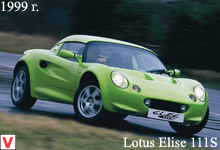
The result - great dynamics (100 km / h the car is gaining in 4.4 seconds). In 1999, at the Geneva Motor Show, the faster Elise was demonstrated, which received an index of 111S. Engine power increased to 158 hp at 7000 rpm, and the maximum torque from 168 to 175 Nm at 4500 rpm, resulting in a threshold of 100 km / h, the 111S overcomes in 5.3 seconds. The beginning of the new century was marked by the appearance of the second generation Elise. The car debuted in the fall of 2000 at the Birmingham Auto Show. He received a new look, in which the classics had almost no space left, and modernity acquired a defiant character.
The exterior is not devoid of aggression and flashy details of the external design. A unique body was created by a subsidiary of Lotus Engineering. It consisted of a carrier space frame made of aluminum, glued with a special, especially strong aviation glue, a rear steel subframe and panels mounted from a kevlar composite hung on the frame. Of course, not everyone will like this bright style. One thing is guaranteed: in such a car you will not be deprived of the attention of others.
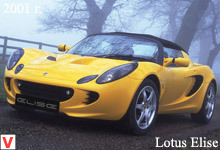
In the interior they used polished aluminum, the seats were covered with black fabric. For an extra charge, the Elise can be supplemented with air conditioning, an audio system with a CD changer, Alcantara trim, and perforated brake discs. It is noteworthy that all models were assembled under the order, and the price was agreed directly with the plant. The basic version received the Rover K-Series of 1.8 liter R4 16V with a 120 hp VVT system.
and 168 Nm, and 5-speed manual gearbox RG1. The maximum speed is 202 km / h. Acceleration to 100 km / h in 5.9 seconds. In 2002, Lotus produced two “charged” modifications of the Elise model, which were named Elise 111 and Elise 111S. Outwardly, these modifications can be distinguished by the 8-inch light alloy wheels and a slightly modified rear end. From a technical point of view, these cars are identical and differ only in the level of trim and basic equipment. In the 111S version, the car received a slightly different trim, audio system and air conditioning system.
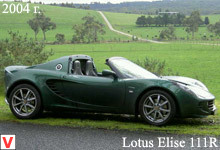
Under the hood of both new products located 1.8-liter engine producing 160 horsepower, and a maximum torque of 175 Nm is achieved in the range of 3 500 - 4 650 revolutions per minute. This motor accelerates a double car to a hundred kilometers per hour in just 5.1 seconds. The maximum speed of the car is 212 kilometers per hour. By the way, this engine uses a variable valve opening time Variable Valve Control. In 2004, a special modification of the Lotus Elise —111R saw the light.
This is a real "urban racing formula." The engine was replaced by a 1.8-liter 16-valve toyotovskuyu "four" 2ZZ-GE, with the timing valve "VVTL-i" and forced to 192 hp at 7800 rpm, resulting in a very high power density of 223 hp per ton of curb weight. Acceleration to 100 km / h takes only 5 seconds. The maximum speed of 241 km / h.
The power unit is paired with a manual 6-speed gearbox.

